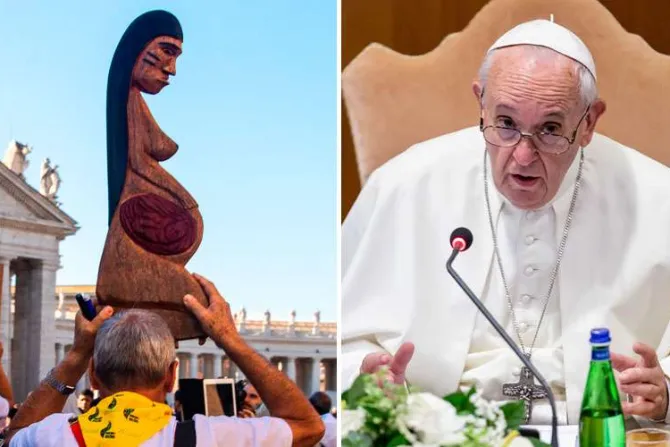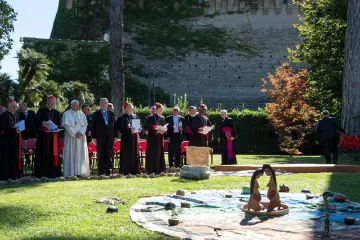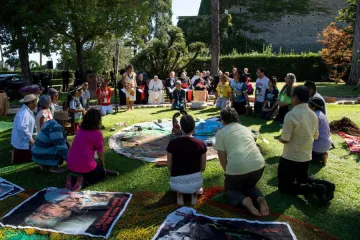Vatican City, Oct 25, 2019 / 09:43 am
After controversial statues were thrown into Rome's Tiber River, Pope Francis has issued an apology during Friday's afternoon session of the Vatican's Synod of Bishops on the Amazon.
"As bishop of this diocese," Pope Francis, who is Bishop of Rome, said, "I ask forgiveness from those who have been offended by this gesture."
Pope Francis also reported that the statues had been recovered from the river, are not damaged, and are being kept in the offices of the head of Italy's national police.
The statues, which were identical carved images of a naked pregnant Amazonian woman, had been displayed in the Carmelite church of Santa Maria in Traspontina, close to the Vatican, and used in several events, rituals, and expression of spirituality taking place during the Oct. 6-27 Amazonian synod.
The pope said they had been displayed in the church "without idolatrous intentions," according to a transcript provided by the Vatican press office.
The statues were thrown into the river Oct. 21; a video released on YouTube showed two men entering the Church, leaving with the statues, and then throwing them off a nearby bridge.
The figures have become symbols of controversy during the synod of bishops, which is a meeting held to discuss the Church's life and pastoral ministry in the Amazonian region of South America. They first appeared at an Oct. 4 tree-planting ceremony in the Vatican gardens, attended by Pope Francis, at which they were in the center of a collection of figurines around which attendees processed.
According to the transcript provided by the Vatican, the pope referred to the statues as "Pachamama," the name traditionally given to an Andean fertility goddess, which can be roughly translated as "Mother Earth."
While it is unclear whether he was using it colloquially, the pope's use of the term "Pachamama" will likely further ongoing debate regarding the exact nature of the statutes, and what they represent.
They had been described as representing "Our Lady of the Amazon," and some journalists initially suggested they represented the Blessed Virgin Mary.
Vatican spokesmen have said that they represent "life," and are not religious symbols, but some journalists and commentators have raised questions about the origins of the symbols, and whether they were religious symbols of Amazonian indigenous groups.
Paolo Ruffini, head of the Vatican's communications office, said last week that "fundamentally, it represents life. And enough. I believe to try and see pagan symbols or to see... evil, it is not," he said, adding that "it represents life through a woman."
He equated the image to that of a tree, saying "a tree is a sacred symbol."
The pope said that the statues might be displayed during the closing Mass of the synod Oct. 27, saying that would be a matter for the Vatican's Secretary of State to decide.
Transcript of Pope Francis' Oct. 25 remarks, as provided by the Holy See Press Office:
"Buon pomeriggio, vi vorrei dire una parola sulle statue della pachamama che sono state tolte dalla chiesa nella Traspontina, che erano lì senza intenzioni idolatriche e sono state buttate al Tevere.
(Story continues below)
Prima di tutto questo è successo a Roma e come vescovo della diocesi io chiedo perdono alle persone che sono state offese da questo gesto.
Poi comunico che le statue, che hanno creato tanto clamore mediatico, sono state ritrovate nel Tevere. Le statue non sono danneggiate.
Il Comandante dei Carabinieri desidera che si informi di questo ritrovamento prima che la notizia diventi pubblica. Al momento la notizia è riservata e le statue sono custodite nell'ufficio del Comandante dei Carabinieri italiani.
Il Comando dei Carabinieri sarà ben lieto di dare seguito a qualsiasi indicazione che si vorrà dare circa la modalità di pubblicazione della notizia e per le altre iniziative che si vogliono prendere a riguardo, ad esempio, riferisce il comandante,'l'esposizione delle statue durante la Santa Messa di chiusura del Sinodo', si vedrà. Io delego il Segretario di Stato che risponda a questo.
Questa è una bella notizia, grazie."
This story is developing and has been updated.





